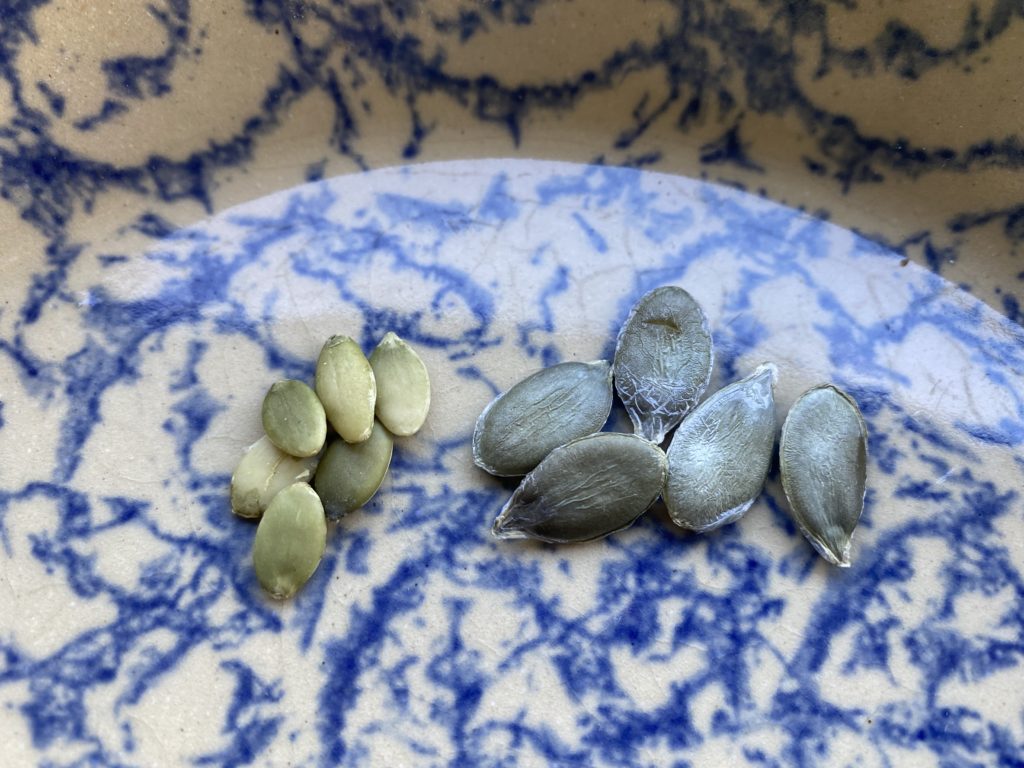Homegrown Pepitas Are the Best!

Much larger, richer, home-grown pepitas on the right.
What Are Pepitas? How Are They Different from Pumpkin Seeds?
If you’ve ever carved a Jack O’Lantern, or grown your own eating pumpkins, you’ll know that pumpkin seeds have a thick, white hull. The entire seed can be consumed, hull and all (an excellent source of fiber), and in the US at Halloween, whole pumpkin seeds are often served as a snack when tossed in butter or olive oil, salt, and spices and roasted.

Inside the tough hull is a green, oil-rich seed. Pumpkin seed oil, pressed from these seeds, is rich in Omega-3 and -6 fatty acids, and vitamin A. It has long been prized as a highly-nutritious and flavorful oil enjoyed in a variety of culinary preparations from cakes to salad dressing.
The nut meat itself – called a pepita – is delicious raw or roasted, and stores well. Because hull-ing the pepitas is fiddly, hull-less varieties were developed so we can enjoy these nutty, delicious seeds without the time-consuming work of removing the hull.
Pepitas are a prized calorie crop, rich in healthy fats (16 g/serving), protein (10 g), and an excellent source of Iron, Potassium, Magnesium, Copper and Phosphorus.

Why It’s Worth Growing Your Own Pepitas
Organic pepitas are a delicious, nutritious addition to our family’s diet. They can command a high price in the grocery store, but are easy to grow, and harvest in our garden. They’re also a really rewarding crop to be able to source locally right out the back door.
If you look back at the first photo in this post, you can see storebought pepitas versus our homegrown seeds. The homegrown are much larger, nuttier in flavor, and richer in those healthy oils than the storebrands, and come with a much smaller carbon footprint.
I’m a big fan of an F1 Hybrid variety called Naked Bear, which produces a moderately-sized bright yellow pumpkin packed full of seeds. It is hardy and yields heavy crops (4-5 plants produces our family’s yearly supply of pepitas). The leftover pumpkin flesh isn’t so great for human consumption, but can be steamed and fed to the chickens and ducks, who will eat it all (raw pumpkin isn’t particularly palatable to poultry, but they love it cooked).
We mostly enjoy pepitas either in pesto, or granola (you can find a VERY old recipe from my very old and rather embarrasing blog here. The recipe is the one I still use today, but instead of 1 1/2 cups walnuts, I use a mix of walnuts sourced from my dad’s trees, and pepitas and hazelnuts from our own garden.)

If you’d like to learn more about growing and harvesting pepitas in the home garden, check out my video below:
Pepita Varieties for Home Gardens
If you want to try to grow your own pepitas, I recommend the following varieties (sourced from seed companies I trust and order from):
Naked Bear
Williams Naked
Kakai Hulless
Pepitas
Styrian Hull-less
I hope you’ll consider growing pepitas in your own garden. They’re a really easy, and fulfilling crop – great for kids and adults to try, and absolutely delicious.
